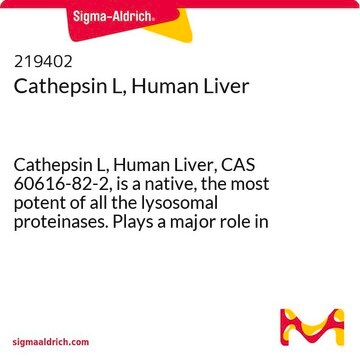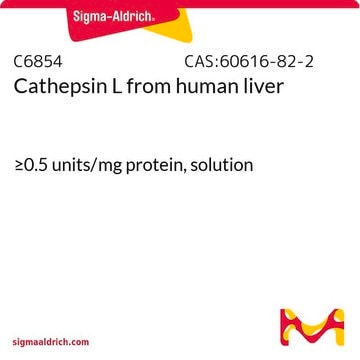437695
Anti-Lipoic Acid Rabbit pAb
liquid, Calbiochem®
Synonym(s):
Anti-LA
Sign Into View Organizational & Contract Pricing
All Photos(1)
About This Item
UNSPSC Code:
12352203
NACRES:
NA.43
Recommended Products
biological source
rabbit
Quality Level
antibody form
diluted serum
antibody product type
primary antibodies
clone
polyclonal
form
liquid
does not contain
preservative
species reactivity (predicted by homology)
all
manufacturer/tradename
Calbiochem®
storage condition
OK to freeze
avoid repeated freeze/thaw cycles
isotype
IgG
shipped in
wet ice
storage temp.
−70°C
target post-translational modification
unmodified
General description
Rabbit polyclonal antibody supplied as diluted serum. Recognizes native lipoic acid and lipoic acid covalently attached to proteins.
Recognizes native lipoic acid. Does not recognize lipoic acid modified by 4-HNE (4-hydroxy-2-noneal) and other lipid peroxidation products.
This Anti-Lipoic Acid Rabbit pAb is validated for use in ELISA, Frozen Sections, Immunoblotting, Paraffin Sections for the detection of Lipoic Acid.
Immunogen
lipoic acid conjugated to KLH
Application
ELISA (1:500-1:1000)
Frozen Sections (1:50-1:500)
Immunoblotting (1:1000-1:10,000)
Paraffin Sections (1:50-1:500)
Frozen Sections (1:50-1:500)
Immunoblotting (1:1000-1:10,000)
Paraffin Sections (1:50-1:500)
Warning
Toxicity: Standard Handling (A)
Physical form
serum diluted in buffer, 50% glycerol, pH 7.5.
Other Notes
Does not bind lipoic acid modified by 4-HNE (4-hydroxy-2-noneal) and other lipid peroxidation products. Useful for assessing whether protein-bound lipoic acids have undergone certain forms of oxidative modification. The presence of protein-bound lipoic acid can be used as a marker for mitochondria. Variables associated with assay conditions will dictate the optimal working dilution.
Sasaki, M., et al. 2000. J. Autoimmun.15, 51.
Heitzer, T., et al. 2001. Free Radic. Biol. Med.31, 53.
Patrick. L. 2000. Altern. Med. Rev.5, 290.
Shi, S.S., et al. 1999. Antioxid. Redox Signal1, 123.
Humphries, K.M. and Szeda, L.I. 1998. Biochemistry37, 15835.
Heitzer, T., et al. 2001. Free Radic. Biol. Med.31, 53.
Patrick. L. 2000. Altern. Med. Rev.5, 290.
Shi, S.S., et al. 1999. Antioxid. Redox Signal1, 123.
Humphries, K.M. and Szeda, L.I. 1998. Biochemistry37, 15835.
Legal Information
CALBIOCHEM is a registered trademark of Merck KGaA, Darmstadt, Germany
Not finding the right product?
Try our Product Selector Tool.
Storage Class Code
10 - Combustible liquids
WGK
WGK 1
Certificates of Analysis (COA)
Search for Certificates of Analysis (COA) by entering the products Lot/Batch Number. Lot and Batch Numbers can be found on a product’s label following the words ‘Lot’ or ‘Batch’.
Already Own This Product?
Find documentation for the products that you have recently purchased in the Document Library.
Caitlyn E Bowman et al.
Cell chemical biology, 24(6), 673-684 (2017-05-10)
Malonyl-coenzyme A (malonyl-CoA) is a central metabolite in mammalian fatty acid biochemistry generated and utilized in the cytoplasm; however, little is known about noncanonical organelle-specific malonyl-CoA metabolism. Intramitochondrial malonyl-CoA is generated by a malonyl-CoA synthetase, ACSF3, which produces malonyl-CoA from malonate
Nicolas L Taylor et al.
Methods in molecular biology (Clifton, N.J.), 372, 389-403 (2008-03-05)
Mitochondria not only are a source of reactive oxygen species (ROS) but also are sites of oxidative damage. In plants, mitochondria must normally operate when there are high levels of ROS produced during photosynthesis and photorespiration. These levels are further
Yvonne Sun et al.
Infection and immunity, 78(11), 4667-4673 (2010-09-09)
Anteiso-branched-chain fatty acids (BCFA) represent the dominant group of membrane fatty acids and have been established as crucial determinants in resistance against environmental stresses in Listeria monocytogenes, a facultative intracellular pathogen. Here, we investigate the role of anteiso-BCFA in L.
Hirokazu Kinugawa et al.
MicrobiologyOpen, 9(10), e1113-e1113 (2020-08-31)
Pyruvate dehydrogenase (PDH) and 2-oxoglutarate dehydrogenase (ODH) are critical enzymes in central carbon metabolism. In Corynebacterium glutamicum, an unusual hybrid complex consisting of CgE1p (thiamine diphosphate-dependent pyruvate dehydrogenase, AceE), CgE2 (dihydrolipoamide acetyltransferase, AceF), CgE3 (dihydrolipoamide dehydrogenase, Lpd), and CgE1o (thiamine
Rosa Purroy et al.
Redox biology, 32, 101520-101520 (2020-04-13)
Friedreich ataxia (FA) is a cardioneurodegenerative disease caused by deficient frataxin expression. This mitochondrial protein has been related to iron homeostasis, energy metabolism, and oxidative stress. Previously, we set up a cardiac cellular model of FA based on neonatal rat
Our team of scientists has experience in all areas of research including Life Science, Material Science, Chemical Synthesis, Chromatography, Analytical and many others.
Contact Technical Service





